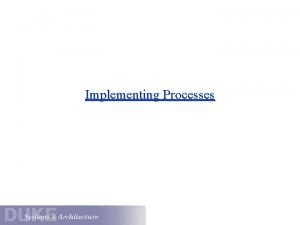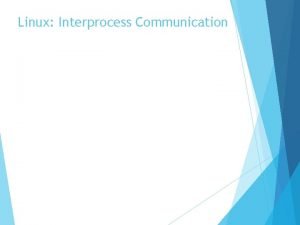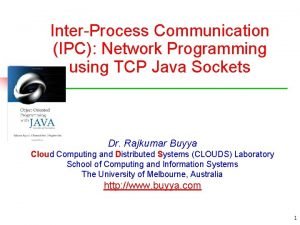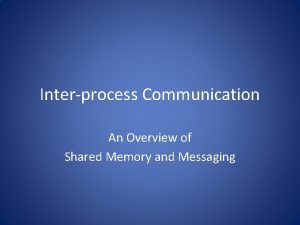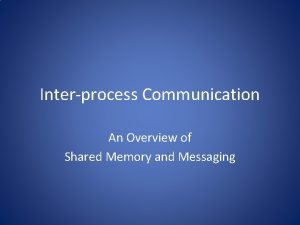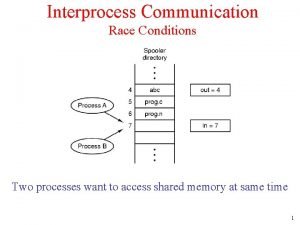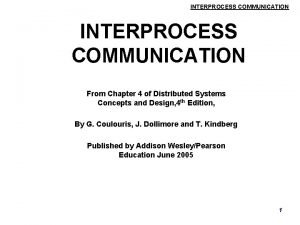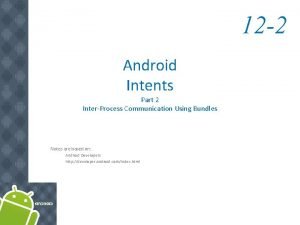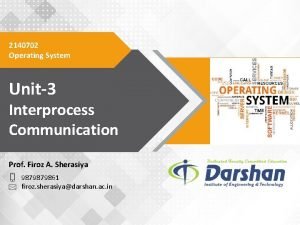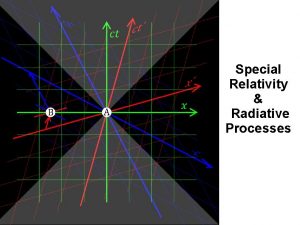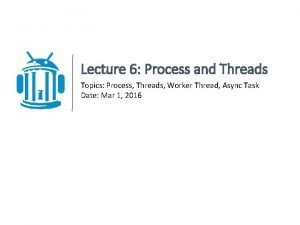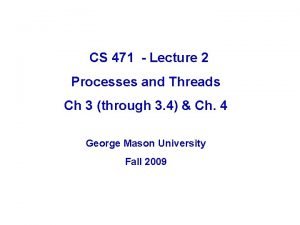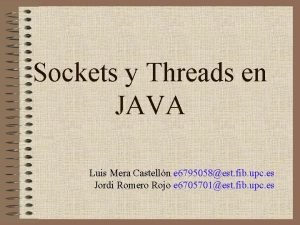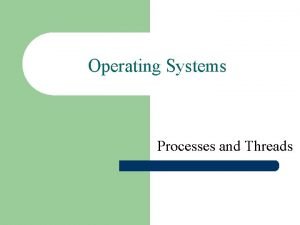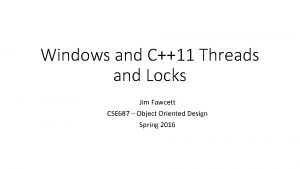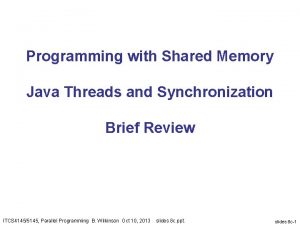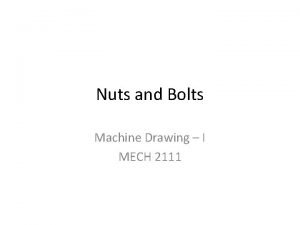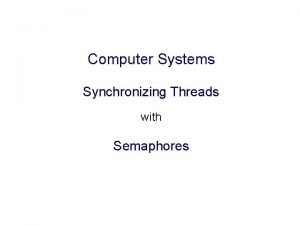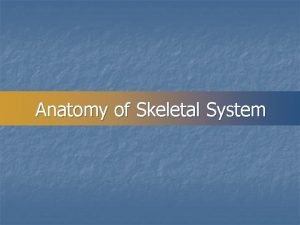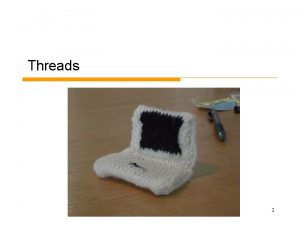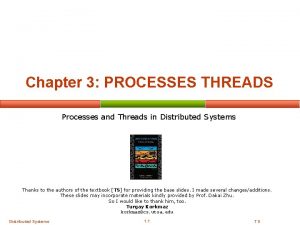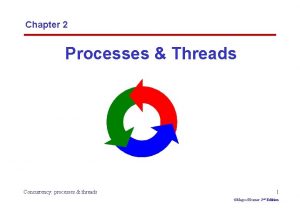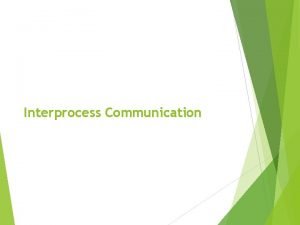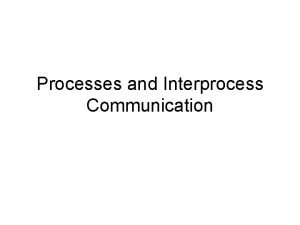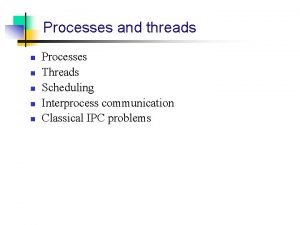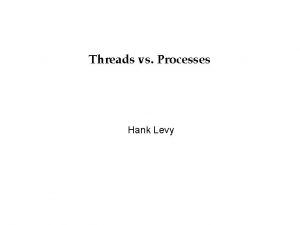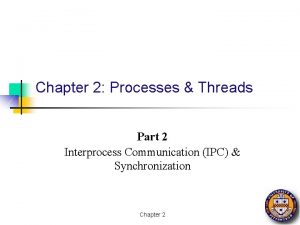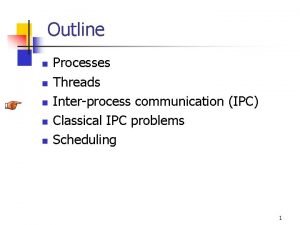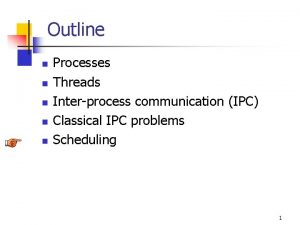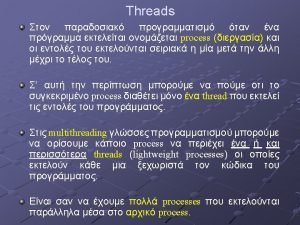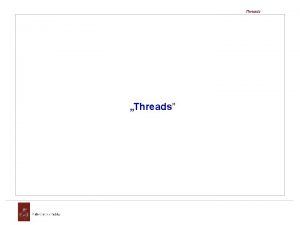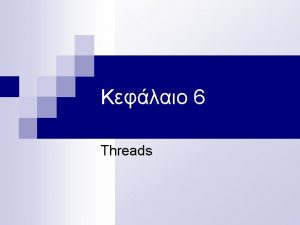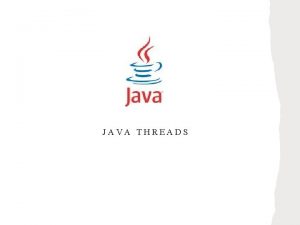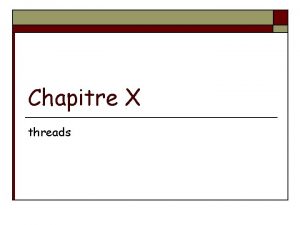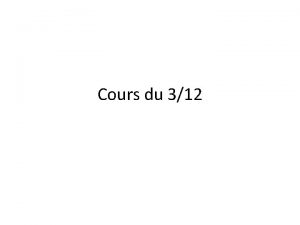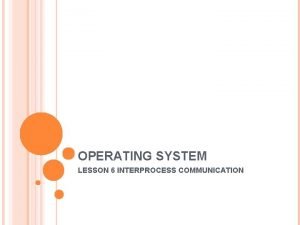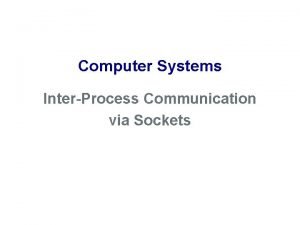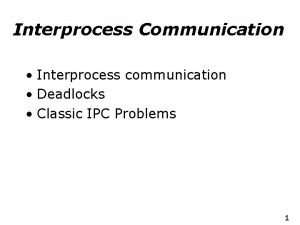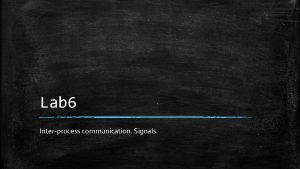Chapter 2 Processes and Threads 2 3 Interprocess























- Slides: 23

Chapter 2 Processes and Threads 2. 3 Interprocess Communication

Race Conditions Figure 2 -21. Two processes want to access shared memory at the same time. Tanenbaum, Modern Operating Systems 3 e, (c) 2008 Prentice-Hall, Inc. All rights reserved. 0 -13 - 6006639

Critical Regions (1) Conditions required to avoid race condition: • • No two processes may be simultaneously inside their critical regions. No assumptions may be made about speeds or the number of CPUs. No process running outside its critical region may block other processes. No process should have to wait forever to enter its critical region. Tanenbaum, Modern Operating Systems 3 e, (c) 2008 Prentice-Hall, Inc. All rights reserved. 0 -13 - 6006639

Critical Regions (2) Figure 2 -22. Mutual exclusion using critical regions. Tanenbaum, Modern Operating Systems 3 e, (c) 2008 Prentice-Hall, Inc. All rights reserved. 0 -13 - 6006639

Mutual Exclusion with Busy Waiting Proposals for achieving mutual exclusion: • • • Disabling interrupts Lock variables Strict alternation Peterson's solution The TSL instruction Tanenbaum, Modern Operating Systems 3 e, (c) 2008 Prentice-Hall, Inc. All rights reserved. 0 -13 - 6006639

Strict Alternation Figure 2 -23. A proposed solution to the critical region problem. (a) Process 0. (b) Process 1. In both cases, be sure to note the semicolons terminating the while statements. Tanenbaum, Modern Operating Systems 3 e, (c) 2008 Prentice-Hall, Inc. All rights reserved. 0 -13 - 6006639

Peterson's Solution Figure 2 -24. Peterson’s solution for achieving mutual exclusion. Tanenbaum, Modern Operating Systems 3 e, (c) 2008 Prentice-Hall, Inc. All rights reserved. 0 -13 - 6006639

The TSL Instruction (1) Figure 2 -25. Entering and leaving a critical region using the TSL instruction. Tanenbaum, Modern Operating Systems 3 e, (c) 2008 Prentice-Hall, Inc. All rights reserved. 0 -13 - 6006639

The TSL Instruction (2) Figure 2 -26. Entering and leaving a critical region using the XCHG instruction. Tanenbaum, Modern Operating Systems 3 e, (c) 2008 Prentice-Hall, Inc. All rights reserved. 0 -13 - 6006639

The Producer-Consumer Problem . . . Figure 2 -27. The producer-consumer problem with a fatal race condition. Tanenbaum, Modern Operating Systems 3 e, (c) 2008 Prentice-Hall, Inc. All rights reserved. 0 -13 - 6006639

Semaphores . . . Figure 2 -28. The producer-consumer problem using semaphores. Tanenbaum, Modern Operating Systems 3 e, (c) 2008 Prentice-Hall, Inc. All rights reserved. 0 -13 - 6006639

Mutexes Figure 2 -29. Implementation of mutex lock and mutex unlock. Tanenbaum, Modern Operating Systems 3 e, (c) 2008 Prentice-Hall, Inc. All rights reserved. 0 -13 - 6006639

Mutexes in Pthreads (1) Figure 2 -30. Some of the Pthreads calls relating to mutexes. Tanenbaum, Modern Operating Systems 3 e, (c) 2008 Prentice-Hall, Inc. All rights reserved. 0 -13 - 6006639

Mutexes in Pthreads (2) Figure 2 -31. Some of the Pthreads calls relating to condition variables. Tanenbaum, Modern Operating Systems 3 e, (c) 2008 Prentice-Hall, Inc. All rights reserved. 0 -13 - 6006639

Mutexes in Pthreads (3) . . . Figure 2 -32. Using threads to solve the producer-consumer problem. Tanenbaum, Modern Operating Systems 3 e, (c) 2008 Prentice-Hall, Inc. All rights reserved. 0 -13 - 6006639

Monitors (1) Figure 2 -33. A monitor. Tanenbaum, Modern Operating Systems 3 e, (c) 2008 Prentice-Hall, Inc. All rights reserved. 0 -13 - 6006639

Monitors (2) Figure 2 -34. An outline of the producer-consumer problem with monitors. Tanenbaum, Modern Operating Systems 3 e, (c) 2008 Prentice-Hall, Inc. All rights reserved. 0 -13 - 6006639

Message Passing (1) . . . Figure 2 -35. A solution to the producer-consumer problem in Java. Tanenbaum, Modern Operating Systems 3 e, (c) 2008 Prentice-Hall, Inc. All rights reserved. 0 -13 - 6006639

. . . Message Passing (2) . . . Figure 2 -35. A solution to the producer-consumer problem in Java. Tanenbaum, Modern Operating Systems 3 e, (c) 2008 Prentice-Hall, Inc. All rights reserved. 0 -13 - 6006639

Message Passing (3). . . Figure 2 -35. A solution to the producer-consumer problem in Java. Tanenbaum, Modern Operating Systems 3 e, (c) 2008 Prentice-Hall, Inc. All rights reserved. 0 -13 - 6006639

Producer-Consumer Problem with Message Passing (1) . . . Figure 2 -36. The producer-consumer problem with N messages. Tanenbaum, Modern Operating Systems 3 e, (c) 2008 Prentice-Hall, Inc. All rights reserved. 0 -13 - 6006639

. . . Producer-Consumer Problem with Message Passing (2) Figure 2 -36. The producer-consumer problem with N messages. Tanenbaum, Modern Operating Systems 3 e, (c) 2008 Prentice-Hall, Inc. All rights reserved. 0 -13 - 6006639

Barriers Figure 2 -37. Use of a barrier. (a) Processes approaching a barrier. (b) All processes but one blocked at the barrier. (c) When the last process arrives at the barrier, all of them are let through. Tanenbaum, Modern Operating Systems 3 e, (c) 2008 Prentice-Hall, Inc. All rights reserved. 0 -13 - 6006639
 Thread vs process
Thread vs process Threads vs processes
Threads vs processes Interprocess communication in linux
Interprocess communication in linux Ipc java
Ipc java Shared memory linux
Shared memory linux Interprocess communication in os
Interprocess communication in os Race condition in interprocess communication
Race condition in interprocess communication Characteristics of inter process communication
Characteristics of inter process communication Android interprocess communication
Android interprocess communication Producer-consumer problem
Producer-consumer problem General vs special relativity
General vs special relativity Concurrent processes are processes that
Concurrent processes are processes that Process and threads
Process and threads Process and threads
Process and threads Sockets and threads
Sockets and threads Process and threads in operating system
Process and threads in operating system C11 thread
C11 thread Shared memory java
Shared memory java Internal screw thread
Internal screw thread A flexible flat material made by interlacing threads/fibers
A flexible flat material made by interlacing threads/fibers Escalonamento por prioridades
Escalonamento por prioridades Os threads
Os threads Basket of threads buddhism
Basket of threads buddhism Needle like threads of spongy bone
Needle like threads of spongy bone

